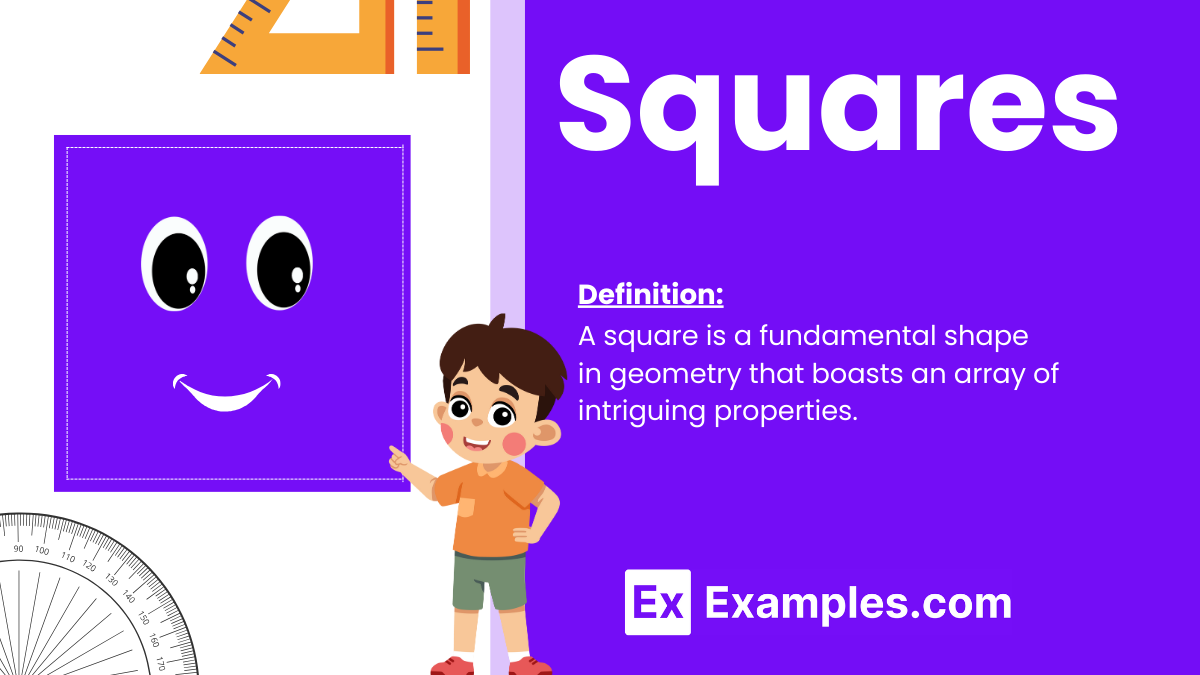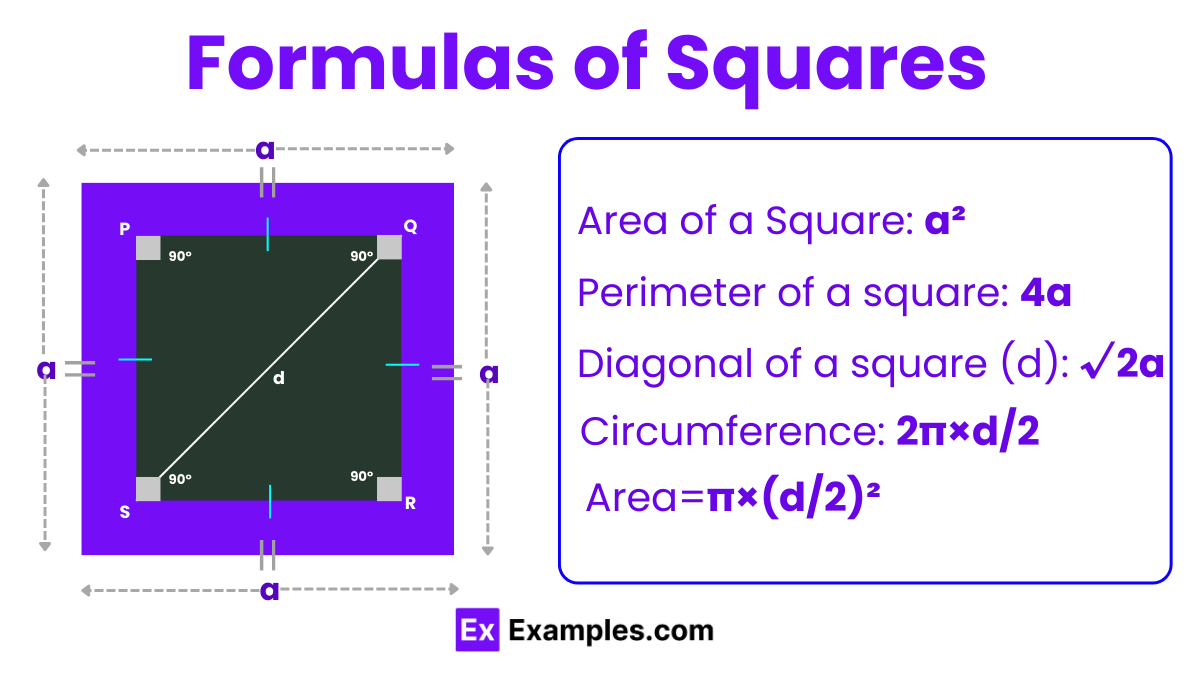What is the square of 7?
49
56
72
84

A square is a fundamental shape in geometry that boasts an array of intriguing properties. Defined by its four equal-length sides and four right angles, a square stands out as a special type of rectangle where all sides have the same measurement. This unique characteristic gives rise to its distinctive symmetry and balance, making it a foundational element in both mathematics and various applications in daily life.

A square, a fundamental figure in geometry, is celebrated for its simplicity and symmetry. It is defined as a quadrilateral with four equal sides and four right angles. The properties of a square make it a unique and special case among polygons, particularly rectangles.
- Uniformity of Sides: Each side of a square has the exact same length, denoting a perfect symmetry and balance. This equality of sides sets the square apart as a regular polygon, where all sides and angles are equal.
- Orthogonal Corners: A square features four right angles, each measuring exactly 90 degrees. This property ensures that a square is not only a rectangle but also a figure of precise regularity and orthogonality.
- Diagonal Properties: The diagonals of a square are of equal length, intersect at the center, and divide each other into two equal parts. Moreover, they are perpendicular to each other, further highlighting the square’s symmetry.
- Diagonal Symmetry: Beyond their equality and perpendicularity, the diagonals of a square bisect its angles. This means that they cut the square’s angles in half, ensuring that the symmetry of the square extends to its diagonals as well.
- Calculating Area: The area of a square is found by squaring the length of one of its sides (Area = side²). This straightforward formula is a direct consequence of its equal-sided property.
- Determining Perimeter: The perimeter of a square, which is the total length of its boundaries, is calculated as four times the length of one side (Perimeter = 4 × side), a reflection of its uniformity.
- Circumscribed Circle: A square has a circumscribed circle (a circle that passes through all its vertices), highlighting its rotational symmetry.
- Inscribed Circle: Similarly, a square can inscribe a circle (a circle contained within the square touching all its sides), demonstrating its central symmetry.
The area of a square is calculated by squaring the length of one of its sides. Since all sides of a square are equal, the formula is quite straightforward:
Area=side²
For example, if one side of a square is 6 units, the area is 6² = 36 square units.
The perimeter of a square is the total length of all its sides. Given that a square has four sides of equal length, the formula to calculate the perimeter is:
Perimeter=4×side
So, if the length of a side is 6 units, the perimeter would be 4×6=24units.
The diagonal of a square connects two opposite corners, passing through the square’s center. The length of the diagonal can be found using the Pythagorean theorem, given that a diagonal splits the square into two right triangles. The formula is:
Diagonal=side×√2
Therefore, if the side of the square is 6 units, the length of the diagonal is 6×√2≈8.49 units.
Calculate the area of a square whose side length is 8 units.
Answer: Use the formula for the area of a square, A = side²
Thus, A = 8² = 64 square units.
A square has a perimeter of 48 units. Find the length of one side.
Answer: The formula for the perimeter of a square is P=4×side.
Thus, side = P/4 = 48/4 = 12unit
If the diagonal of a square is 14 units long, what is the area of the square?
Answer: The formula relating the diagonal (d) of a square to its side (s) is d = s√2
So, s = d/√2 = 14/√2 = 7√2units
Then , The area is A= s² = (7√2)²=98Square unit.
How long is the diagonal of a square with a side length of 5 units?
Answer: Use the diagonal formula, d = s√2.
d=5√2 ≈ 7.07 units.
The area of a square is 81 square units. What is the perimeter of this square?
Answer: First, find the side length: s² = 81, So s = 9units.
Then, calculate the perimeter: P= 4×s = 4×9 = 36 units.
If the area of a square is equal to the square of its perimeter, what is the side length of the square?
Answer: Let s be the side length. The area is s², and the perimeter is 4s. According to the question, s² = (4s)² . Simplifying, s² = 16s² , which is not possible under normal circumstances since it implies s = 0 for any non-zero coefficient. This question seems to be incorrectly stated as it suggests an impossible scenario under conventional geometric rules.
A diamond shape, often referred to in geometry as a rhombus, is not necessarily a square. While both have four sides, a square requires all angles to be 90 degrees, which is not a requirement for a diamond. The key difference lies in the angles.
A rhombus is not always a square, but a square is a type of rhombus. The distinction hinges on the angles; a square has four right angles, whereas a rhombus has equal sides but not necessarily equal angles. A square meets all rhombus criteria and the additional requirement of right angles.
Yes, a square is a type of parallelogram. It not only has opposite sides that are parallel and equal in length, but it also has all four angles equal to 90 degrees. A square meets all the criteria of a parallelogram, with the added feature of equal angles and sides.
Learning squares easily involves practice and pattern recognition. Start by memorizing small squares as a base. Notice patterns, such as the last digit cycle for squares of numbers ending in 5, and use multiplication shortcuts for quick calculation. Regular practice enhances recall.
Text prompt
Add Tone
10 Examples of Public speaking
20 Examples of Gas lighting
What is the square of 7?
49
56
72
84
Which of the following numbers is a perfect square?
15
36
50
75
If the square of a number is 121, what is the number?
10
11
12
13
What is the next perfect square after 16?
20
24
25
26
What is the square of 15?
225
200
150
175
Which number squared gives 144?
10
12
14
16
Which of the following is not a square number?
64
81
100
90
The square of which number is 49?
6
7
8
9
What is the square of 8?
56
64
72
91
Which number is the square root of 81?
8
9
10
11
Before you leave, take our quick quiz to enhance your learning!

